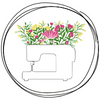

A few thoughts you might be having..
1. So what even is a modiste?
Modiste is an old French term for a maker of women’s fashion. (moh-deest)
Because here at TFM, that’s exactly what we’re doing—making women’s fashion.
2. What does TFM stand for?
The Flora Modiste stands for the art of making, for the art of creating clothing with your own two hands. For being conscious of your wardrobe, and for adding meaningful pieces to your closest that are made for you, by you.
Because when you add meaningful pieces to your wardrobe, you are more likely to hold on to them longer—which in turn benefits this beautiful planet of ours.
3. “I have always wanted to learn how to sew..”
Girl, I cannot even count how many times I have heard this statement in my life. If you want to learn how to sew, then let's do it!
And that’s where TFM comes in.


So I hate to break it to you.. but there isn’t really any “secret” to learning how to sew. No magic project, course, or product. You just have to start.
By sewing all kinds of different projects—that’s how you learn to sew.
And while yes, there are a lot of different sewing patterns, projects, and companies out there—I can promise you that sewing pattern quality varies widely.
Which is why I searched far and wide to create the absolute best sewing patterns on the market:
• Envelopes: Our sewing pattern envelopes are made of a thick, durable card stock that will safely store your pattern for years to come.
• Sewing Pattern: Every TFM pattern is printed on a beautifully thick white paper—no flimsy, delicate tissue paper here.
• Instruction Manual: Our manuals include clear, full color photos with instructions written in plain, conversational language.
And one of the best parts about TFM sewing patterns? They are printed by an ethical company (that I myself have visited) based in the UK.


So I don’t know about you—but I do not have time to waste wandering around a fabric store, wondering if a fabric or trim will work for a project.
Let alone the time to pick the wrong fabric, sew up the project, and have it turn out so badly I don’t even wear it--which is why I sourced and created our DIY kits.
Every single part that makes up a TFM DIY kit has been tested by yours truly, and is of the highest quality:
• Printed Materials: As mentioned above, all of our materials are printed on thick, high quality paper by a small business based in the UK.
• Fabric: All of our fabrics are made of natural, organic materials.
• Thread: The thread we use is a high quality, multi-purpose thread that is produced by a small company here in the states.
• Custom Clothing Tag: Our custom “made by the flora modiste & me” tags add a complete, finished look to any me-made sewing project.
It’s hard enough just finding the time to sew—let’s make it as easy as possible to get there.

Girl, we’ve got a tutorial for that. With nearly 100 posts on the blog, TFM covers how to sew all different kinds of construction details and sewing projects, often using step-by-step sewing tutorials.
Popular blog posts & tutorials

You don’t have to be an artist, or “the creative type”, or a sewing expert to make your own clothes—girl, you (yes you) can do this!


No matter what level you are at—whether you’ve been sewing for decades or just bought a sewing machine yesterday—TFM has got you covered.

First things first--pick a sewing pattern:
• The Sheath Dress—A slip on dress with giant front pockets sewn into the princess seams.
• The Matching Two Piece—The sweetest crop top (with or without sleeves!) paired with a high waisted skirt, complete with those signature giant front pockets.
Want the full DIY kit? The fabric for the Dany DIY kit is the brightest Sunny Daisy organic cotton knit.
—OR—
THE JUPITER: A wrap skirt in collaboration with the vegan, sustainable brand Vesta. The skirt has multiple hem & pocket options, my favorite being..
• Patch pockets + the midi length
• Inseam side pockets + the maxi length
Want the full DIY kit? The fabric for the Jupiter DIY kit is a beautiful black and white woven made from a blend of hemp & organic cotton.
Pick your project and you’re one step closer to becoming a modiste--it’s as simple as that.

Every seamstress needs to build a basic sewing kit in order to start sewing. Once you’ve picked your project, make sure to build up your kit!


It’s easy to overlook hand sewing—but I have found it absolutely essential throughout my sewing education. It’s important to be intentional about practicing it!

Why? Oh, because if you’re..
Stuck and can’t figure out how to sew something? Hand stitch it.
Working with a fabric that can’t be hemmed with a machine? Hand stitch it.
Looking for a project where you can sit on the sofa for hours, all without having to get your machine out? Girl, you know what’s coming—hand stitch it.
Some of my favorite hand sewing practice methods over the years have included:
• Hand sewing hems: Instead of doing the basic machine stitched hem, practice your hand sewing.
• Literally just practice: Grab some spare fabric and practice all different kinds of hand stitches to see what you like. (Check out both part one + part two in our hand stitching series for ideas!)
• Hand stitch a quilt: This is quite the endeavor, but I absolutely perfected my hand sewing skills after 100+ hours on my (first ever) quilting project. Make sure to check out parts one, two, three, AND four in our series on quilting for beginners.


















